 HL7 CCPM, R1 HL7 Version 3 Standard: Orders; Substances CMETs, DSTU Release 11 June 2011 |
Content Last Edited: 2011-06-14T14:26:17
Chemical substances of interest for the engineering, research and development of pharmaceutical and diagnostic products and methods.
|
||||||||||||||
|
For details on the interpretation of this section, see the description of RMIMs in the Version 3 Guide.
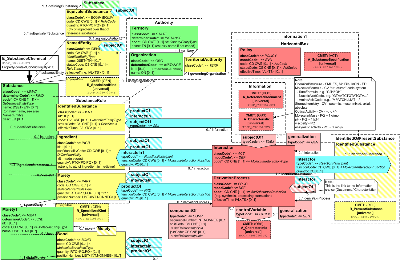
| Parent: | ProductKind (POCP_DM010000UV) |
The usual entry point for a substance submission is the IdentifiedSubstance role. The entry point on the Substance entity allows the detailed substance structure to be used in combination with other entities (e.g., directly connected to formulations.)
The Substance Entity class represents the substance (as a universal). Upon hearing the word "substance", one may think of (1) a larger amount of this substance, such as a pail full of a liquid, as sizeable crystal, or of (2) a single smallest quantum of the substance, such as a single molecule or a single complex. Which intuition we choose determines how we consider the notions of quantity (measured vs. counted) or part (a cup from the pail, chip from the crystal vs. a molecular substructure, or moiety, from the molecule). Whether we have a single molecule or a large amount, however, is only a difference in quantity (many singular entities make up the amount and there is no amount of the substance smaller than its singular molecule.
The differences in the conception of part along this quantity axis are in no way special even macroscopic objects can be subdivided into parts in different ways. E.g., a loaf of bread can be divided into (1) crust outside and the crumb inside or (2) it may be divided into slices; in whole-grain bread, one may (3) discern on elongated bread, such as French Baguette, the ends from the shaft; and one may (4) dissect individual kernels of grain from the more homogenous polymerized starch mass. Thus it is with substances also: they may be dissected into portions, regional parts, and molecular parts. The molecular parts are called moieties.
The Substance is identified by a code, which is the primary code, a primitive without further post-coordination and no translations. Any use case where the Substance needs to be related to other conceptualizations of the same (or sufficiently equivalent) Substance, shall use the EquivalentSubstance role. The SpecializedKind structure can be used, as always, to declare the Substance a specialization of any number of Substance classifications.
The IdentifiedSubstance role, also one of the entry points to the Substance model, declares that this substance, identified by that id, is so identified by the scoping Organization or for the scoping region ("Territory"). The substance id (extension and root) and the playing Substance Entity's code (code and codeSystem) must be the same. This will allow references to Substances as Entities and in a generic IdentifiedSubstance role to resolve to one unique object.
Moiety is a molecular part, or, more generally, a part of the smallest amount (quantum) of the substance. Moiety is a structural part, meaning that removal of such parts changes the nature of the substance. Conversely, removal of a portion from a crystal does not change the substance. The Moiety class in the model is a partitive Role class with a code attribute, allowing the further distinction of the kinds of molecular subdivisions.
Moieties may be constructed of smaller moieties (e.g., functional groups). For example, if one wishes to say that one of the hydrogen atoms on a benzene ring is substituted with a hydroxyl group (to form phenol), one may say that the base moiety is benzene but a Modification exists connecting the benzene with a hydroxyl group. Note, this detail of small molecules may be (and often would be) conveyed in encapsulated structure specifications elsewhere. However, for larger molecules, such as proteins, the sub-moieties would specify the existence of, for example, a glycan or phosphate residue substituted on the base moiety.
When substances are being defined based on moieties, these base moieties are often stated by their basic Substance code that stands for the unmodified substance. However, this would create a problem, since the code in the Substance would mean that the substance is unmodified, when in fact it is being modified by the connection with the Modification role. To prevent ambiguity, one must in these cases provide also a unique identifier on the base substance. This identifier makes the modified Substance special and different from the unmodified Substance referenced in the code.
Moiety1 (Entity) is the substance that is the part of the larger substance. Rather than repeating all the descriptive elements on the Moiety1 (Entity), the Moiety1 (Entity)'s code contains the code of another defined Substance so its description may be looked up (or can be sent with the same data package).
Bond: A bond is a connection between two specified moieties. Normally, moiety structures can be specified simply by breaking down the molecule into its part moieties and breaking those moieties down further. However, when multiple bonds exists between moieties, those may be specified. This can also be used to specify all the bonds in case where the moieties are provided as a parts list. For instance, in the most general case, a substance is specified by all its elements and all its bonds (this is, for example, how the MDL/MOLFILE format works.) Specific examples of the use of the bond role is to specify a protein based on its sub-units (chains) as moieties and the disulfide bridges specified as bonds connecting the subunits.
The Moiety and Bond roles have quantity and positionNumber attributes. The quantity specifies how many (numerator) of the specified Moieties or Bond exist in the whole molecule or next larger moiety (denominator). The positionNumber allows indicating where the moiety or modification attaches to the base molecule. The detail of how positionNumber is used and interpreted must be specified in the definition of the Moiety.code or Modification.code.
DerivationProcess: specifies how the substance is made. This information is not relevant for substances that are structurally completely defined and should not be used in those cases. The derivation information may be necessary, however, if the substance is not completely defined by exact structure. For example, the exact number and placement of substitutions of additional moieties to a base substance may not be constant, the length of chains of a polymer may not be specified exactly, and the length of chains of a tryptic peptide mix may not be exactly defined. When all that can be said of a substance is what the source material and processes are, then this is specified using the DerivationProcess and referencing the source material as an IdentifiedSubstance.
Interaction allows specifying the counter-part of a molecule which is essentially defined by its interaction. For example, antibodies are defined by their antigen interaction. Likewise, receptors are defined by the target (e.g. hormone) and a complex peptide-hormone may be defined by the receptor that it reacts with. Note, the Interaction structure even allows to specify detailed molecular reactions which form pathways, while this is a logical step with many important applications in biomedical research computing, it is not the main purpose for including the Interaction structure into the Substance model. Here the Interaction structure is intended for use if this Interaction contributes essentially to the very definition of the Substance.
Characteristic is a recurring theme in any specification of material. These Characteristics are observable properties that can be examined (measured) on the substance and their specification contributes to the definition of the substance or provides essential and useful information about the substance. For example, molecular mass can be ascribed to the substance by means of a Characteristic. Coded Characteristics may specify chiral properties of the substance. And Characteristics with encapsulated data can provide a structure specification using a standard external to HL7, such as MOLFILE, SMILES or InChi.
Documents may be references to other substance monographs or journal articles that contribute to the very definition of the substance.
A discussion document that gives examples of these data structures is available at http://pragmaticdata.com/documents/substances.pdf.
| E_SubstanceChemical | POCP_HD082100UV01 |
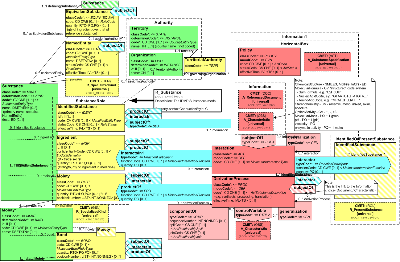
| Parent: | ProductKind (POCP_DM010000UV) |
The usual entry point for a substance submission is the IdentifiedSubstance role. The entry point on the Substance entity allows the detailed substance structure to be used in combination with other entities (e.g., directly connected to formulations.)
The Substance Entity class represents the substance (as a universal). Upon hearing the word "substance", one may think of (1) a larger amount of this substance, such as a pail full of a liquid, as sizeable crystal, or of (2) a single smallest quantum of the substance, such as a single molecule or a single complex. Which intuition we choose determines how we consider the notions of quantity (measured vs. counted) or part (a cup from the pail, chip from the crystal vs. a molecular substructure, or moiety, from the molecule). Whether we have a single molecule or a large amount, however, is only a difference in quantity (many singular entities make up the amount and there is no amount of the substance smaller than its singular molecule.
The differences in the conception of part along this quantity axis are in no way special even macroscopic objects can be subdivided into parts in different ways. E.g., a loaf of bread can be divided into (1) crust outside and the crumb inside or (2) it may be divided into slices; in whole-grain bread, one may (3) discern on elongated bread, such as French Baguette, the ends from the shaft; and one may (4) dissect individual kernels of grain from the more homogenous polymerized starch mass. Thus it is with substances also: they may be dissected into portions, regional parts, and molecular parts. The molecular parts are called moieties.
The Substance is identified by a code, which is the primary code, a primitive without further post-coordination and no translations. Any use case where the Substance needs to be related to other conceptualizations of the same (or sufficiently equivalent) Substance, shall use the EquivalentSubstance role. The SpecializedKind structure can be used, as always, to declare the Substance a specialization of any number of Substance classifications.
The IdentifiedSubstance role, also one of the entry points to the Substance model, declares that this substance, identified by that id, is so identified by the scoping Organization or for the scoping region ("Territory"). The substance id (extension and root) and the playing Substance Entity's code (code and codeSystem) must be the same. This will allow references to Substances as Entities and in a generic IdentifiedSubstance role to resolve to one unique object.
Moiety is a molecular part, or, more generally, a part of the smallest amount (quantum) of the substance. Moiety is a structural part, meaning that removal of such parts changes the nature of the substance. Conversely, removal of a portion from a crystal does not change the substance. The Moiety class in the model is a partitive Role class with a code attribute, allowing the further distinction of the kinds of molecular subdivisions.
Moieties may be constructed of smaller moieties (e.g., functional groups). For example, if one wishes to say that one of the hydrogen atoms on a benzene ring is substituted with a hydroxyl group (to form phenol), one may say that the base moiety is benzene but a Modification exists connecting the benzene with a hydroxyl group. Note, this detail of small molecules may be (and often would be) conveyed in encapsulated structure specifications elsewhere. However, for larger molecules, such as proteins, the sub-moieties would specify the existence of, for example, a glycan or phosphate residue substituted on the base moiety.
When substances are being defined based on moieties, these base moieties are often stated by their basic Substance code that stands for the unmodified substance. However, this would create a problem, since the code in the Substance would mean that the substance is unmodified, when in fact it is being modified by the connection with the Modification role. To prevent ambiguity, one must in these cases provide also a unique identifier on the base substance. This identifier makes the modified Substance special and different from the unmodified Substance referenced in the code.
Moiety1 (Entity) is the substance that is the part of the larger substance. Rather than repeating all the descriptive elements on the Moiety1 (Entity), the Moiety1 (Entity)'s code contains the code of another defined Substance so its description may be looked up (or can be sent with the same data package).
Bond: A bond is a connection between two specified moieties. Normally, moiety structures can be specified simply by breaking down the molecule into its part moieties and breaking those moieties down further. However, when multiple bonds exists between moieties, those may be specified. This can also be used to specify all the bonds in case where the moieties are provided as a parts list. For instance, in the most general case, a substance is specified by all its elements and all its bonds (this is, for example, how the MDL/MOLFILE format works.) Specific examples of the use of the bond role is to specify a protein based on its sub-units (chains) as moieties and the disulfide bridges specified as bonds connecting the subunits.
The Moiety and Bond roles have quantity and positionNumber attributes. The quantity specifies how many (numerator) of the specified Moieties or Bond exist in the whole molecule or next larger moiety (denominator). The positionNumber allows indicating where the moiety or modification attaches to the base molecule. The detail of how positionNumber is used and interpreted must be specified in the definition of the Moiety.code or Modification.code.
DerivationProcess: specifies how the substance is made. This information is not relevant for substances that are structurally completely defined and should not be used in those cases. The derivation information may be necessary, however, if the substance is not completely defined by exact structure. For example, the exact number and placement of substitutions of additional moieties to a base substance may not be constant, the length of chains of a polymer may not be specified exactly, and the length of chains of a tryptic peptide mix may not be exactly defined. When all that can be said of a substance is what the source material and processes are, then this is specified using the DerivationProcess and referencing the source material as an IdentifiedSubstance.
Interaction allows specifying the counter-part of a molecule which is essentially defined by its interaction. For example, antibodies are defined by their antigen interaction. Likewise, receptors are defined by the target (e.g. hormone) and a complex peptide-hormone may be defined by the receptor that it reacts with. Note, the Interaction structure even allows to specify detailed molecular reactions which form pathways, while this is a logical step with many important applications in biomedical research computing, it is not the main purpose for including the Interaction structure into the Substance model. Here the Interaction structure is intended for use if this Interaction contributes essentially to the very definition of the Substance.
Characteristic is a recurring theme in any specification of material. These Characteristics are observable properties that can be examined (measured) on the substance and their specification contributes to the definition of the substance or provides essential and useful information about the substance. For example, molecular mass can be ascribed to the substance by means of a Characteristic. Coded Characteristics may specify chiral properties of the substance. And Characteristics with encapsulated data can provide a structure specification using a standard external to HL7, such as MOLFILE, SMILES or InChi.
Documents may be references to other substance monographs or journal articles that contribute to the very definition of the substance.
A discussion document that gives examples of these data structures is available at http://pragmaticdata.com/documents/substances.pdf.
| R_Substance | POCP_HD080300UV01 |
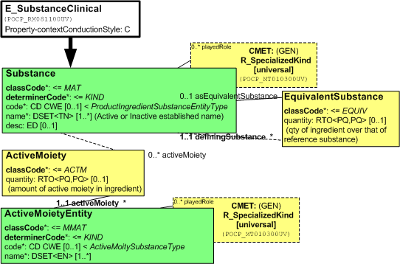
| Parent: | ProductKind (POCP_DM010000UV) |
A substance specified to the extent of clinical detail, i.e., with substance code and name and active moiety, as well as generalizations of either.
| E_SubstanceClinical | POCP_HD081100UV01 |
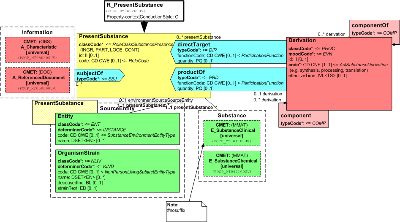
| Parent: | ProductKind (POCP_DM010000UV) |
A substance present at a particular location in an environment, such as an organism, anatomical part of an organism, including sub-cellular structure or any other environment entity.
| R_PresentSubstance | POCP_HD080200UV01 |
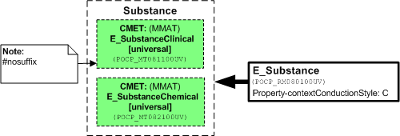
| Parent: | ProductKind (POCP_DM010000UV) |
A choice of substance entity described either to the level of interest for clinical use, or as a detailed chemical substance.
| E_Substance | POCP_HD080100UV01 |
|
||||||||||||||
|
For details on the interpretation of this section, see the description of HMDs in the Version 3 Guide.
Specifies a chemical substance as an entity. Useful when refering to it from different roles.
| R_SpecializedKindUniversal | POCP_MT010300UV01 |
| R_SpecializedKindUniversal | POCP_MT010300UV01 |
| A_CharacteristicUniversal | POCP_MT050500UV01 |
| A_CharacteristicUniversal | POCP_MT050500UV01 |
| A_ReferencedDocumentUniversal | POCP_MT050600UV01 |
| R_PresentSubstanceUniversal | POCP_MT080200UV01 |
| A_SubstanceSpecificationUniversal | POCP_MT090100UV01 |
| E_SubstanceChemical | POCP_MT082100UV01 |
The IdentifiedSubstance role, also one of the entry points to the Substance model, declares that this substance, identified by that id, is so identified by the scoping Organization or for the scoping region ("Territory"). The substance id (extension and root) and the playing Substance Entity's code (code and codeSystem) must be the same. This will allow references to Substances as Entities and in a generic IdentifiedSubstance role to resolve to one unique object.
| R_SpecializedKindUniversal | POCP_MT010300UV01 |
| R_SpecializedKindUniversal | POCP_MT010300UV01 |
| A_CharacteristicUniversal | POCP_MT050500UV |
| A_CharacteristicUniversal | POCP_MT050500UV |
| A_ReferencedDocumentUniversal | POCP_MT050600UV |
| R_PresentSubstanceUniversal | POCP_MT080200UV01 |
| A_SubstanceSpecificationUniversal | POCP_MT090100UV01 |
| R_Substance | POCP_MT080300UV01 |
A substance specified to the extent of clinical detail, i.e., with substance code and name and active moiety, as well as generalizations of either.
| R_SpecializedKindUniversal | POCP_MT010300UV01 |
| R_SpecializedKindUniversal | POCP_MT010300UV01 |
| E_SubstanceClinical | POCP_MT081100UV01 |
A substance as a choice of more specific patters for specifying substances to the clinical extent vs. the chemical extent of detail.
| E_SubstanceClinicalUniversal | POCP_MT081100UV01 |
| E_SubstanceChemicalUniversal | POCP_MT082100UV01 |
| E_Substance | POCP_MT080100UV01 |
A role specifying the substance (player) being present at a particular environment, place, compartment, organism or substructure.
| A_CharacteristicUniversal | POCP_MT050500UV01 |
| A_ReferencedDocumentUniversal | POCP_MT050600UV01 |
| E_SubstanceClinicalUniversal | POCP_MT081100UV01 |
| E_SubstanceChemicalUniversal | POCP_MT082100UV01 |
| R_SubstancePresence | POCP_MT080200UV01 |
| Return to top of page |

